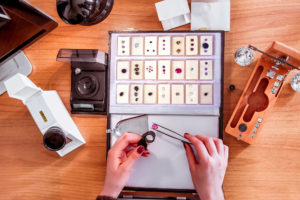Be savvy about sparklers
Be savvy about sparklers.
By Scott Bohall
If you put steak sauce on a hot dog, will it taste like a sirloin?
Consumers have more experience buying food than jewelry. Most of us have bought an item at a ball game or concert where the food and beverage was low quality but four times the normal price. As a captive audience, we buy the stuff. The problem with jewelry is that most people have no idea when they are paying way too much for something of low quality.
Here are a few tips to help find value instead of just a price tag: With any purchase, including diamonds or gemstones, get a statement in writing as to whether a gem has been treated or not. Even if your particular salesperson does not know, someone in the store should. It’s a federal law that any treatment that affects the value of the gem should be disclosed. Only 5 percent of jewelry sold each year has treatments mentioned.
Some gems can only be found treated. Blue topaz is one example. It comes out of the ground white or clear and is treated in a few different ways to produce the various blue shades. If someone tells you a blue topaz is naturally colored, they are wrong. Some gems, like sapphires, are normally heat treated, which is an accepted treatment. Sapphires that have no treatment are very rare and usually cost much more. The challenge is that rubies and sapphires can also be treated in unnatural ways, taking worthless material and turning it into fairly attractive pieces. The unethical jewelers will use this material, which can be worth a mere $20 and sell it for $200 because it looks similar to material that costs $200.
Some wording can also be difficult to understand. “Some gems may be treated” is not enough information to determine what type of treatment was used and whether the treatment is permanent. A new term that is all over the Internet is “created diamond simulant.” A created diamond is a diamond made in a laboratory. A created diamond simulant is something that looks like a diamond but is not and is usually overpriced.
Less than 10 percent of all jewelry salespeople have taken even one professional course about gems. Less than 20 percent of all appraisals are done by someone with an appraisal degree. Less than 30 percent of jewelers who agree to work on your jewelry actually do their own work. Less than 40 percent of all jewelers have a gemologist on staff. And less than 50 percent of all jewelers make their own jewelry.
If you don’t know jewelry, know your jeweler––and be certain your jeweler actually does know jewelry. Whether it’s ice cream or ice, learn to be a savvy consumer.
Related posts
Leave a Comment
You must be logged in to post a comment.







